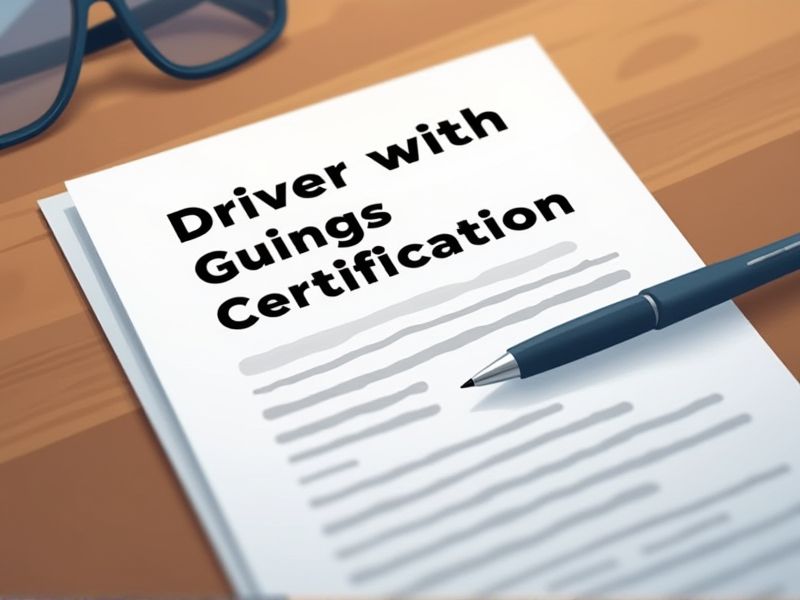
A driver handling dangerous goods requires multiple certifications because these materials pose significant risks to public safety and the environment. Regulations mandate specialized knowledge and skills to effectively mitigate hazards and manage emergency situations. Certifications ensure that drivers are fully equipped to adhere to legal standards and protocols, safeguarding themselves and others. Below are essential certifications that a driver may need when transporting dangerous goods.
Commercial Driver's License (CDL)
Carrying dangerous goods increases the risk factors on the road, necessitating specialized training provided by a Commercial Driver's License (CDL). The CDL ensures drivers understand and comply with regulations specific to hazardous materials, thereby reducing potential accidents. It mandates proficiency in handling emergency situations related to dangerous goods, protecting public safety. Employers often require a CDL as a standard to ensure their drivers can legally and safely transport hazardous materials.
Hazardous Materials Endorsement (HME)
Possessing a Hazardous Materials Endorsement (HME) ensures that drivers have the proper training to identify and handle dangerous goods, reducing the risk of accidents. The endorsement complies with federal and state regulations, allowing drivers to legally transport hazardous materials. Insurance companies often require an HME for coverage, protecting both the driver and the company from potential liabilities. Shippers prioritize drivers with an HME, resulting in more job opportunities for those certified.
U.S. DOT Dangerous Goods Training Certification
The U.S. DOT Dangerous Goods Training Certification ensures drivers understand and comply with federal regulations when transporting hazardous materials, reducing the likelihood of accidents and spills. Proper certification helps prevent legal liabilities and potential fines associated with non-compliance. This training also educates drivers on how to respond to emergencies involving dangerous goods, protecting public safety and the environment. Certification aligns drivers with current best practices and standards in hazardous material transportation, maintaining safety and efficiency in logistical operations.
Transportation of Dangerous Goods (TDG) Certification
Transportation of Dangerous Goods (TDG) Certification ensures drivers understand and comply with regulations that minimize risks during transport. Compliance reduces the likelihood of accidents and environmental damage by enforcing proper handling protocols. Training increases awareness and preparedness for potential hazards associated with dangerous goods. Certification enhances public and worker safety by fostering a culture of responsibility in the transportation industry.
ADR Certification
ADR Certification is necessary because it ensures drivers are aware of and comply with international regulations for the safe transport of dangerous goods. This certification reduces the risk of hazardous material spills and accidents on the road by mandating a standard level of safety knowledge and practices. It facilitates seamless cross-border transport of dangerous goods, as the standards are recognized and enforced across multiple countries. Employers and insurers often require ADR certification to mitigate liability and ensure compliance with legal obligations.
Defensive Driving Course Certification
Defensive driving course certification is crucial for drivers with dangerous goods certification because it enhances their ability to predict and respond to potential road hazards, ensuring safer transport of hazardous materials. Without this certification, the likelihood of accidents increases, posing higher risks of spills and exposure. These courses focus on accident prevention techniques, critical for minimizing the impact of both minor and major incidents. Regulatory bodies often require defensive driving certifications to comply with safety standards and reduce the liability associated with transporting dangerous goods.
Emergency Response Training Certification
Exposure to hazardous substances significantly risks public safety; training equips drivers with the skills necessary for effective emergency management. In crisis situations, rapid decision-making is crucial, and certification ensures drivers are prepared to respond efficiently. Regulatory compliance mandates such certifications to minimize transportation-related incidents and liabilities. Employers benefit from reduced accidents and enhanced safety protocols, leading to minimized operational disruptions.
Occupational Safety and Health Administration (OSHA) Certification
Drivers with dangerous goods certification handle hazardous materials, which pose significant safety risks if mismanaged. OSHA certification ensures these drivers are equipped with necessary safety protocols to prevent accidents and health hazards. Without OSHA certification, drivers might lack comprehensive awareness of workplace safety standards, increasing the likelihood of regulatory non-compliance. Certified drivers enhance safety credibility, reducing potential liabilities and fostering trust with employers and the public.
First Aid and CPR Certification
Drivers transporting dangerous goods often encounter emergency situations, where quick and effective response can significantly mitigate harm. Possessing First Aid and CPR certification equips them with the skills to provide immediate care in case of accidents involving hazardous materials. Regulatory bodies often mandate such certifications to ensure public safety and reduce risks associated with dangerous goods transit. Trained drivers can stabilize situations until professional medical help arrives, potentially saving lives and limiting environmental impact.
Workplace Hazardous Materials Information System (WHMIS) Certification
Obtaining WHMIS certification equips drivers with essential knowledge about hazardous material handling. This certification helps in understanding labeling systems and safety data sheets, which decreases the risk of accidents during transportation. Drivers benefit from enhanced ability to respond appropriately to emergencies involving hazardous goods. Compliance with both WHMIS and dangerous goods certification fosters a safer work environment and meets legal requirements.
Summary
With the new certifications, you enhance your professional credibility and increase your employability in specialized logistics roles. Employers often prioritize certified drivers for roles involving hazardous materials due to the demonstrated commitment to safety and regulatory compliance. Earnings potential typically rises as companies offer competitive compensation for skilled personnel. Having multiple certifications leads to greater career opportunities, providing you versatility within the industry.
